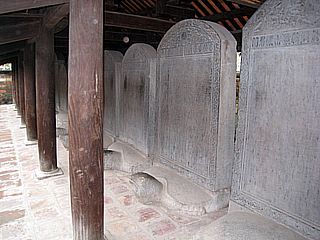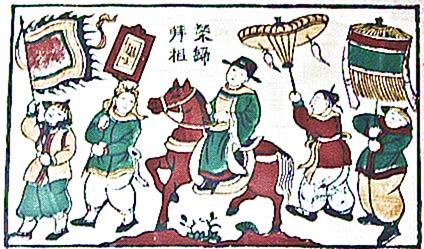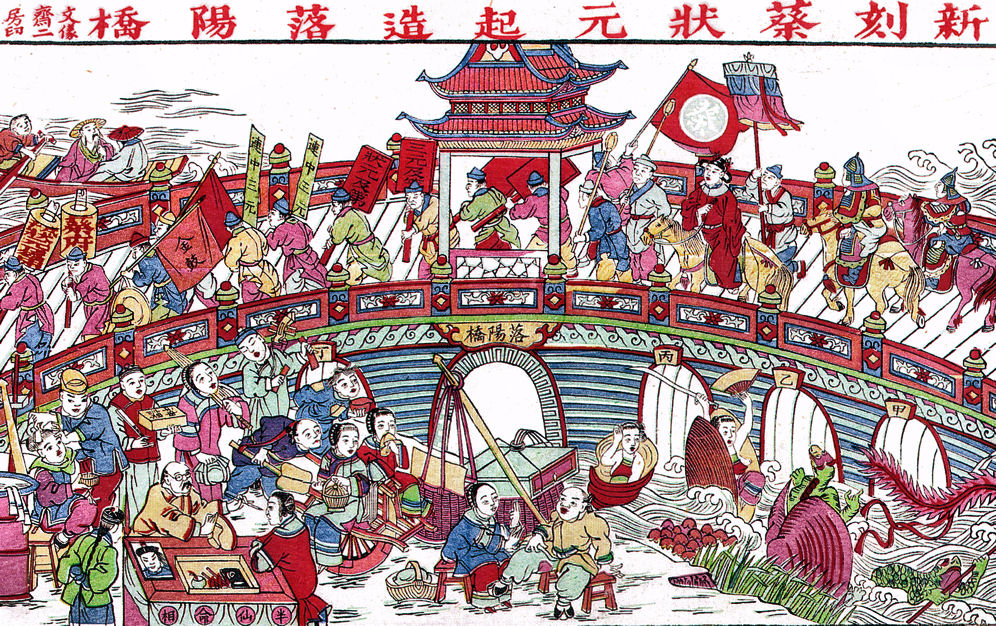Content created: 2000-04-16
File last modified:

Brief Outline of XIXth-Century
Chinese Civil Service Examinations
(Terms worth memorizing:
tóngshēng,
shēngyuán (xiùcái),
jǔrén,
jìnshì)
This page provides a brief overview of the main examination levels of late Imperial China. It is only an overview. Deeper coverage is available in the excellent Wikipedia article on the civil service exams (kējǔ 科举) (link) and another on the exam system’s infamous late imperial essay form, the "eight legged essay" (link).
When using this page, you may find it useful to refer also to the associated Brief Outline of Chinese Administrative Units.
It is probably easiest to think about these degrees by equating them with American university degrees, based roughly on age at passing the relevant exams. However the proportion of individuals with academic degrees is very much higher in modern America than in XIXth-century China.
 Commemorative Stelae
Commemorative Stelae Hanoi's Temple of Literature, dedicated to Confucius, houses stelae commemorating scholars who passed the jìnshì
进士 exam
The numbers provided here emphasize how extraordinarily poor the chances were of a person reaching the highest level of the examination system, which were protected by strict quotas, quotas which did not keep up with population growth. (For comparison, in 2023 about 2,600,000 people applied for civil service exams for 37,100 appointments, a success rate of only 0.6%.) The terms "early" and "late" refer to the 50-year periods before and after 1850. Population is assumed to have been about 410,000,000 in the first half of the XIXth century.
Given how rarely people passed these exams, each success at doing so was greeted with riotous rejoycing by the successful candidate's family and friends, and commemmorated by stone monuments of various kinds both at his home and in "temples of literature" around the nation.
The picture above shows part of a large pavilion of the Temple of Literature in Hanoi, which still shelters stone monuments to students from that region who reached the top while Vietnam was governed by Imperial China. The folk woodcuts just below (also from Vietnam) and at the bottom of the page (from China) show the triumphant return home of new graduates, each with his entourage of banner-bearing servants and perhaps even a couple of armed guards.
The English terms are more or less conventional translations. Traditional characters are added in blue when they differ from the simplified character set (in red).
Level-A Exam
(lowest = tóngshēng 童生 "young & fresh"; commoners)
- EXAM NAME:
- Type 1: Zhōu-xiàn Shì 州县试 / 州縣試 (District Exam)
- Type 2: Fǔ-zhōu Shì 府州试 / 府州試 (Prefectural Exam)
- PLACE:
- Type 1: Zhōu 州 or Xiàn 县 / 縣 level
- Type 2: Fǔ 府
- QUOTA:
- Type 1: none
- Type 2: almost none after early Míng dynasty.
- STATUS AFTER PASSING: Tóngshēng 童生
- INTERVAL: varied between provinces
- NUMBER IN POPULATION AT ANY ONE TIME:
- 2% (varies between early .7% in Ānhūi province to 3.5% in Yúnnán province and late .6% to 5%)
- GRADER:
- Zhōu 州 and Xiàn 县 / 縣 magistrates.
- REMARKS:
- Candidates initially called Jùnxiù 俊秀. Passers were still considered commoners.
Level-B Exam
("BA" = shēngyuán 生员 "new member" / 生員 or xiùcái 秀才 "excellent talent"; lower gentry)
 "The Confucian Scholar
"The Confucian Scholar
Worships His Ancestors"This widely distributed and copied motif shows a successful new graduate returning home in glory. I found the copy here pasted in the cabin of a Vietnamese river boat.
- EXAM NAME: Tóng Shì 童试 / 童試 or Yuàn Shì 院试 / 院試
- PLACE: native districts & prefectures
- QUOTA: Early: 0.1 to 0.15% or 25,089. Late: 30,113
- STATUS AFTER PASSING: Shēngyuán 生员 / 生員 (colloquial: xiùcái 秀才
- INTERVAL:
- civilian exam: 2 in 3 years;
- military exam: 1 in 3 years.
- PRODUCTION IN 3 YEARS: civilian: 50,000; military: 21,233
- NUMBER IN POPULATION AT ANY ONE TIME:
- Early: civilian: 526,869; military: 212,330, total: 738,199 (=.18% of the population, or slightly under 2 per thousand of population)
- Late: total: 210,597 (= 0.24% or slightly over 2 per thousand of population)
- AVERAGE AGE AT PASSING: 24
- GRADER: Provincial Director of Studies
- REMARKS:
- The degree of Jiànshēng 监生 / 監生 "inspector") was available by purchase at this level, permitting a person to take the Level-C exam without passing this Level B first. Both Level-B and Jiànshēng degree holders were considered lower gentry.
Level-C Exam
("MA" = jǔrén 举人 / 舉人 ) ("elevated person"; upper gentry)

- EXAM NAME: Xiāng Shì 乡试 / 鄉試 = Provincial Exam
- PLACE: Province capital
- QUOTA: 1,439
- (plus one Fùchē 副车 / 副車 or "honorable mention" per 5 jǔrén)
- STATUS AFTER PASSING: Jǔrén 举人 / 舉人
- INTERVAL: 1 every 3 years
- PRODUCTION IN 3 YEARS:
- Early: 1,400 civilian, 1,011 military.
- Late: 1,500 civilian, 1,011 military.
- NUMBER IN POPULATION AT ANY ONE TIME:
- Early: civilian: 15,500, military: 11,500, totaling 0.0065% of the population, or about 6 per hundred thousand of population.
- AVERAGE AGE AT PASSING: 31
- REMARKS: Passers were considered upper gentry.
Level-D Exam
("PhD" = jìnshì 进士 / 進士 ) ("scholar who has entered [the palace]"; highest gentry)
- EXAM NAME: Hùi Shì 会试 / 會試 = Metropolitan Examination
- PLACE: Běijīng
- QUOTA: yes
- STATUS AFTER PASSING: Gòngshì 贡士 / 貢士
- This title was seldom used, since a subsequent pro forma examination called the Diàn Shì 殿试 / 殿試 or "Palace Examination" was held immediately afterward conferring the coveted title of Jìnshì 进士 / 進士 .
- INTERVAL: 1 every 3 years
- PRODUCTION IN 3 YEARS: 550
- NUMBER IN POPULATION AT ANY ONE TIME:
- 2500 civilian, 1500 military, 4000 total (= 0.0009% of the population, or 9 per million of population)
- AVERAGE AGE AT PASSING: 35
- REMARKS: Passers were considered highest gentry.

"Newly Graduated Top Scholar Cài 蔡 Arriving by Horse
at the Bridge in Luòyáng 洛阳"
In the XIXth century, cheaply produced woodcuts like this one from northern China would presumably have been presented to families by well-meaning friends to inspire greater scholastic application by their potentially erring offspring. (Unfortunately, it would have been easy for a bored student to get intrigued by all that is going on along the river or even floating in the river itself. Can YOU make up a story to go with the figure waving a fan from the giant clam shell?)
Sources:
The engraving is from Justus DOOLITTLE 1865 The Social Life of the Chinese (New York: Harper) vol 1, p. 415. The XIXth-century woodcut is a product of a northern Chinese woodcut shop. The Vietnamese photos were taken by DKJ. The data presented are based largely on CHANG Chung-li 1955 The Chinese Gentry (Seattle: University of Washington Press). I am indebted to William Parish of the University of Chicago for useful discussions of this material. The number of exam passers in 2023 is from The Economist, 2023.11.18 p. 36.
Return to top.





